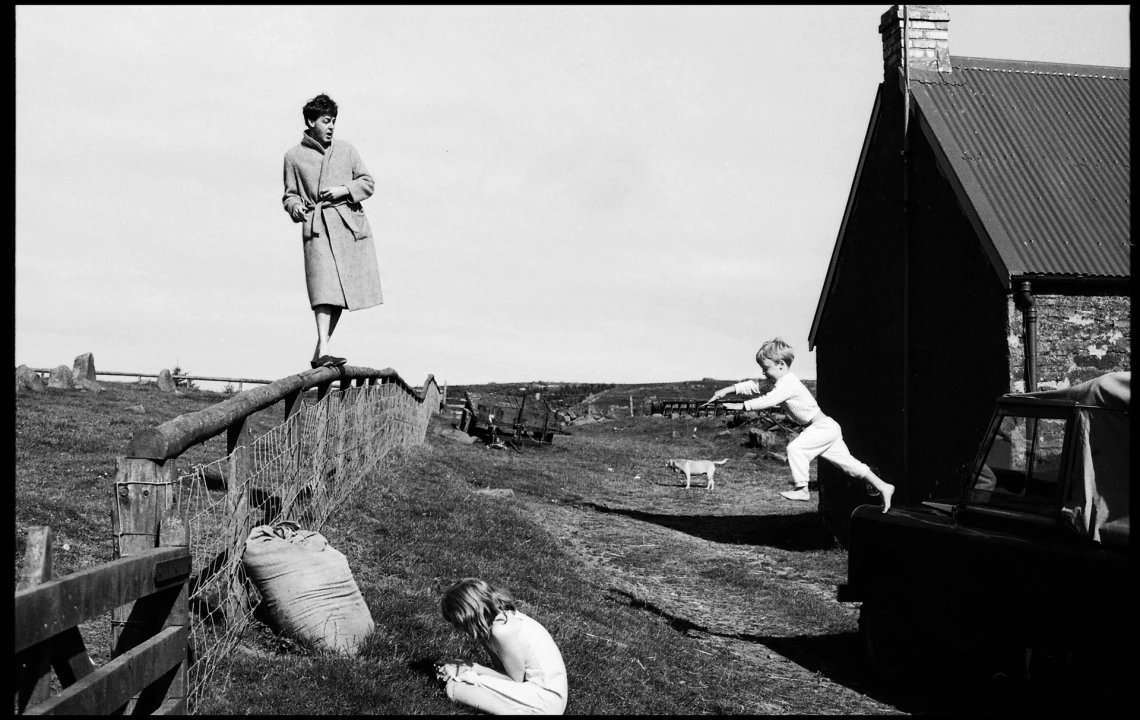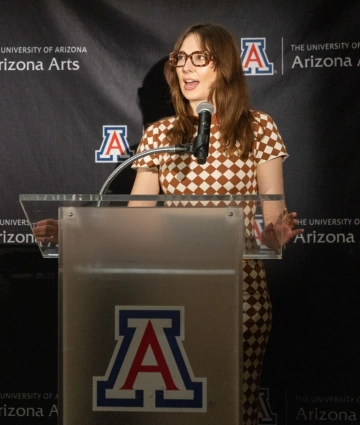An Inside Look: The Linda McCartney Experience
Her moving images of Tucson, family life and the famous get their first North American retrospective at the Center for Creative Photography.

"Paul, Stella and James." Scotland, 1982.
Linda McCartney
Q&A: Sarah Brown, Linda McCartney Archive Curator
WHEN WAS THE LINDA MCCARTNEY ARCHIVE ESTABLISHED, AND WHEN DID YOU BECOME INVOLVED AS ITS CURATOR?
Linda McCartney Archive was established after Linda’s passing in 1998, but it has significantly become more of its own entity in the past five years. I joined as the curator in 2016 and have focused on touring exhibitions of Linda’s work internationally and raising her profile as a photographer through different projects, one being a book of Linda’s Polaroids that was published in 2019 by Taschen. 2023 marks the 10-year anniversary of the Linda McCartney Retrospective first being put together by the McCartney family, and to honor that, as well as Linda’s deep connection to Tucson, we have added never-before-been-seen pieces from Linda’s archive.
HOW MANY OF HER PIECES ARE NOW IN THAT ARCHIVE?
The archive is expansive, with nearly 160,000 items. This includes over 5,000 original Polaroids as well as vintage prints, contact sheets and her photo negatives and transparencies, which have been digitized thanks to a dedicated archiving team.
CAN YOU TALK ABOUT THE PROCESS OF SELECTING REPRESENTATIVE PIECES FOR THIS RETROSPECTIVE?

Sarah Brown
Chris Richards
For the retrospective at the Center for Creative Photography, curators Rebecca Senf ’94 and Meg Jackson Fox ’16 visited the Linda McCartney Archive in person in London to look at Linda’s vintage prints and to discuss what would make exciting and relevant additions to the Tucson exhibition.
Rebecca was particularly interested in the works Linda had made with other artists and the ways in which she collaborated with artists who worked in different mediums than her. Three works were chosen to highlight Linda’s artistic collaborations, with none having been exhibited before.
The first piece is a stained-glass window by Linda and artist Brian Clarke, which depicts a Linda photograph of a saguaro cactus.
The other two pieces are experimental screen prints Linda made with British pop artist Allen Jones. We are also exhibiting some of Linda’s earliest work, which she took in Tucson, as well as six prints taken in Tucson in the 1980s and 1990s. Again, these photographs have not been exhibited before and were chosen by the CCP’s Meg Jackson Fox.
Linda’s Tucson photographs create a beautiful narrative between Linda’s work and that of Hazel Larsen Archer, photographer and art educator, who first inspired Linda to start taking photos and is also the subject of the accompanying exhibition to the retrospective: Sessions on Creative Photography.
WHAT LED YOU TO PICK THE UNIVERSITY OF ARIZONA TO MOUNT LINDA’S FIRST RETROSPECTIVE IN NORTH AMERICA?
In 2018, Anne Breckenridge Barrett reached out to the archive and was instrumental in bringing the retrospective to the University of Arizona. Through Anne, we were introduced to what the Center for Creative Photography has to offer, and the McCartney family was particularly impressed by the interdisciplinary nature of the center and its connection to students and the local community. This unique aspect made the center, and university, seem like the right fit for the first showing of the retrospective in North America. That, and feeling like somewhat of a homecoming for Linda’s work, as Tucson is where she first picked up a camera 60 years ago. Tucson was a place very close to Linda McCartney’s heart. It’s where she took some of her favorite work and where she passed away.
WHICH OF LINDA’S ARTWORK IN THE SHOW IS YOUR FAVORITE AND WHY?
It is so hard to choose favorites, but I do have a few that I go back to time and time again. One is “Mother and Child, Corfu, 1969.” It shows a woman on a beach in Corfu in a bright orange hat covered in 3D flowers. She is about to pick up her daughter, and the daughter, through spectacle-framed eyes, is staring right back at Linda, and in turn the viewer. The more I look at the image, the more it makes me think about European paintings from the 14th and 15th centuries of the Madonna and Child, where the Virgin Mary embraces the child. Here, however, we have the “pre-embrace” of the child, something that is rarely depicted but Linda has captured, and it provides a lot to analyze and think about. What I also love about this image is that there is somehow humor in the image, most likely due to the orange hat, which today would seem so out of place on a beach. Linda’s Polaroids and cyanotypes are also some of my favorite works in the exhibition.
CAN YOU DISCUSS WHY LINDA AND PAUL AND THEIR FAMILY WERE (AND ARE) SO FOND OF TUCSON?
Linda first moved to Tucson from New York City in the early 1960s to study art history at the University of Arizona. She described Tucson as somewhere she could embrace being a free spirit and said that she found Arizona to be one of the most visually inspiring states in the U.S., where you could see “sunsets supreme.” So when Linda introduced Tucson to Paul and their family, they also found beauty in the landscape and freedom in the nature here. I also think they always felt welcomed by the local community, while at the same time being given the respect of privacy. Linda’s enchantment with the Tucson landscape is evident in her pictures on show in the retrospective, from saguaros to her use of light and shadow. Her Tucson photos, for me, are indeed some of her most visually inspiring.
Interested in McCartney's Photography?
The Linda McCartney Retrospective is on exhibit together with Sessions on Creative Photography: Hazel Larsen Archer until Aug. 5, 2023 at the Center for Creative Photography. You also can learn more about McCartney’s photography below:

